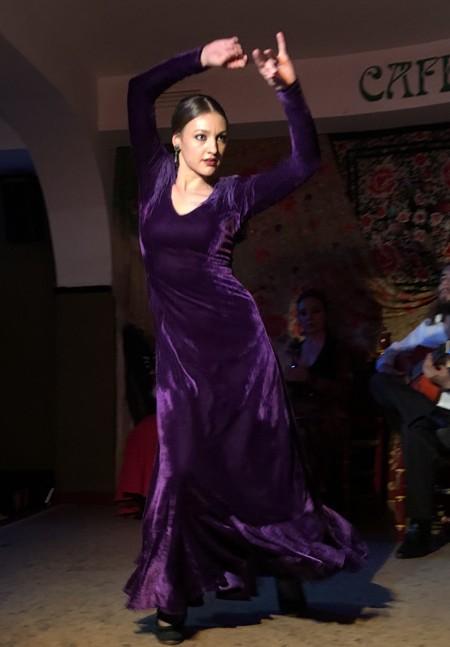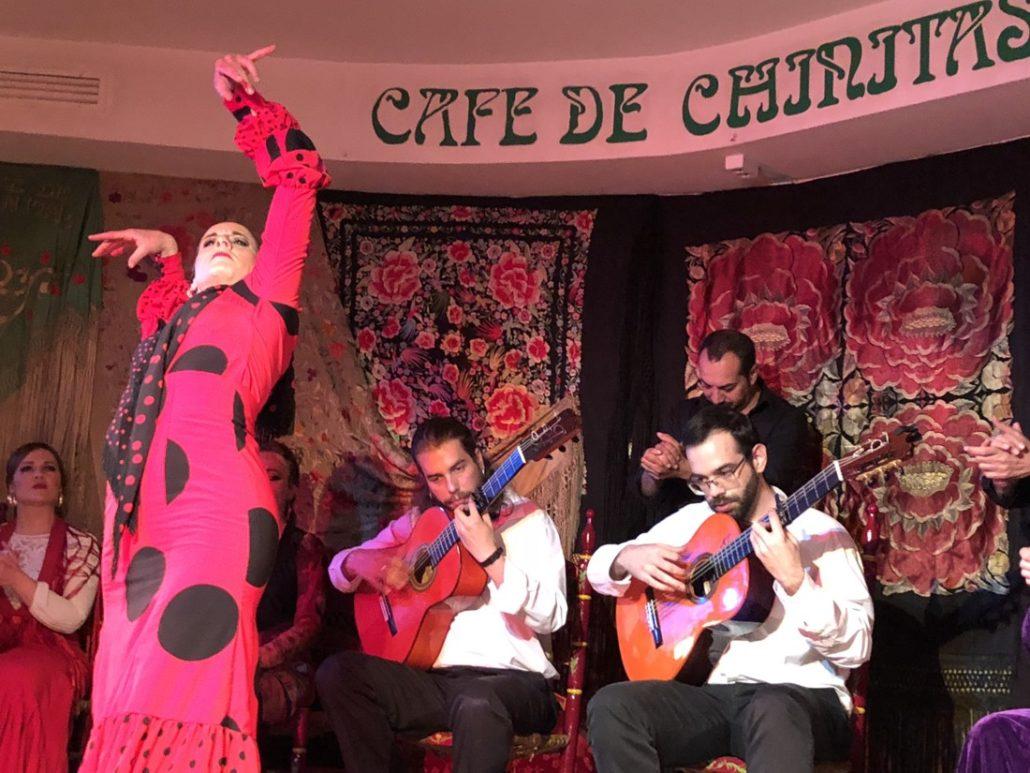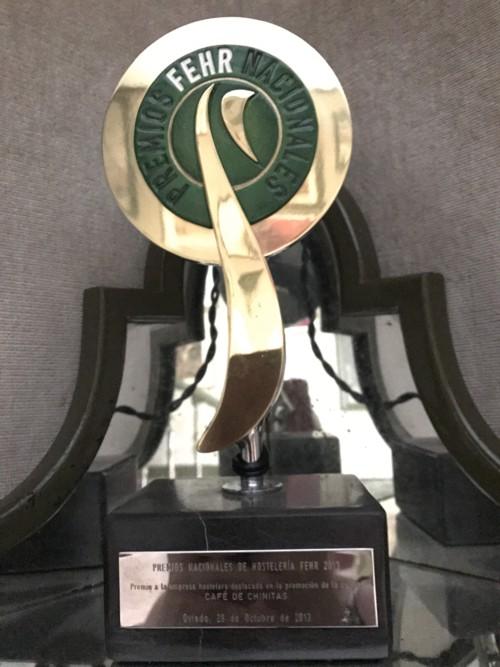At the Café de Chinitas,
Paquiro told his brother:
“I’m braver than you,
more of a fighter and more of a gypsy.”
At the Café de Chinitas,
Paquiro said to Frascuelo:
“I’m braver than you,
more of a gypsy and more of a fighter.”
Paquiro took out his watch
and proclaimed:
“This bull must die
before 4:30 PM.”
When the 4 PM bells rang,
they left the cafe
and in the street, Paquiro became
a poster-ready bullfighter.
THE FLAMENCO OF CAFÉ DE CHINITAS
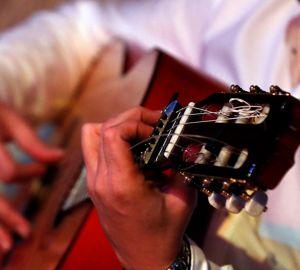
At that time, there was a small bar in Malaga with a tiny stage, with only six box seats on either side reserved for the most important spectators of the city: the Café Chinitas. It was known then as “El Chinitas” or the “Café de Chinitas”, and its story starts in 1857 with the businessman Antonio Maria Alvarez, who would eventually become governor of Malaga. Many legends surround the origins of the café’s name, but the most likely story is that it comes from one of the most successful actors of the time, Gabriel Lopez; now forgotten but then known as “El Chinitas”, thus giving name to one of the most popular and influential tablaos (flamenco halls) at the end of the 19th century.
One day, more than a century later, the Verdasco family is out on a terrace in Plaza del Oriente, enjoying the fresh air and the live music of a street musician, when a transcendental decision is made: motivated by the financial crisis of the 1960s, they needed to transform one of their current businesses in the nearby Calle de la Torija. Inspired by the music being played around them, one of the family asks, “Why don’t we start a flamenco tablao?” “We don’t know anything about that kind of business, but I’m sure we could ask friends for help…” answered another. Many questions and concerns were brought up, but with the certainty that help would come from friends and family around them, the decision was made and the adventure was begun
Despite not knowing much about the ins and outs of flamenco, the Verdasco family did have the knowledge acquired from previous generations, especially from great-grandmother Cándida Santos, founder of their multi-generational family business. She had taught them the importance of following one’s dreams and never giving up, particularly with her own actions in 1870 when she moved from her hometown in Asturias to Madrid to open La Bola, the family’s first restaurant, now open for nearly 150 years.
Thus, breaking all the rules, the flamenco tablao of Chinitas was opened in an old 18th century palazzo, inspired by the most important cantante café of Spain, the original Café de Chinitas in Malaga, as well as by one of the Café’s most important clients, beloved Spanish poet Federico Garcia Lorca. Within a few short months, Madrid’s Café de Chinitas grows in fame thanks to the special collaboration of the famous bailaora (dancer), La Chunga.
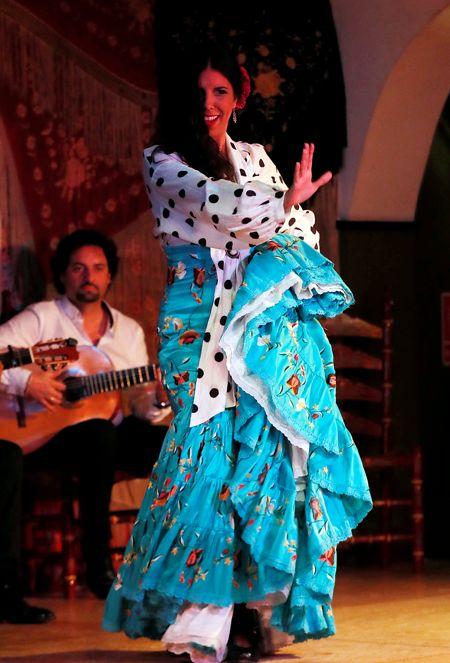 Café de Chinitas quickly becomes known as the best of its kind. Some of the biggest stars of the flamenco world have passed across the wood boards of its stage under the direction of Tomas de Madrid, including but not limited to: La Chunga with her bare feet and spontaneous talent; the legendary Rosario, who shared a stage and awards with Antonio; Maria Albaicín, “the most Spanish one,” whose beauty was ¬¬¬¬honored on the cover of Live; Carmen Mora, winner of the National Dance Prize; Pastora Imperio and the irresistible Morucha… The very best cantaores (singers) of all different styles… We could also mention Maria Vargas, whose magnificent talents bring the listener back to the glory days of the three great rivals, all fighting for artistic splendor, of Gabriel Moreno, classic and profound; Enrique Morente, ground-breaking and light-hearted; and El Lebrijano, genuine and brilliant.
Café de Chinitas quickly becomes known as the best of its kind. Some of the biggest stars of the flamenco world have passed across the wood boards of its stage under the direction of Tomas de Madrid, including but not limited to: La Chunga with her bare feet and spontaneous talent; the legendary Rosario, who shared a stage and awards with Antonio; Maria Albaicín, “the most Spanish one,” whose beauty was ¬¬¬¬honored on the cover of Live; Carmen Mora, winner of the National Dance Prize; Pastora Imperio and the irresistible Morucha… The very best cantaores (singers) of all different styles… We could also mention Maria Vargas, whose magnificent talents bring the listener back to the glory days of the three great rivals, all fighting for artistic splendor, of Gabriel Moreno, classic and profound; Enrique Morente, ground-breaking and light-hearted; and El Lebrijano, genuine and brilliant.
No less brilliant is Jose Mercé, who began his artistic career on this stage before becoming one of the best-known flamenco artists of our day and age. On guitar we cannot forget the magical Serranito, whose performances were true show-stoppers. Through the years we have hosted artists such Tomás de Madrid, Rosario, Rosa Durán, María Albaicín, Carmen Mora, Pastora Vega, Morucha, María Vargas, Gabriel Moreno, Enrique Morente, Loli Flores, El Lebrijano, Serranito, Matilde Coral, Rafael El Negro, El Farruco, Carmen Casarrubios, Tere Maya, Cuqui Fierro, Dolores Amaya, Concha Vargas, El Indio Gitano, Enrique Escudero, Carmen Linares, El Chaquetón, Luis Habichuela, Felipe Maya, Amador, Manzanita, La Polilla, Lola Serrano, La Globo, Carlos Habichuela, Candi, Mariano Torres, Ramón El Portugués, Juan Varea, Mario Maya, Mariquilla, Gómez de Jerez, Lucía Albarrán, Ramón de Cádiz, Maruja Heredia, Angela Grande, Sebastián Manzano, Ricardo El Veneno, Faiquillo, Toni Maya, Miguel Carmona, Salvador Suero, El Entri, Monchi, Andrés Heredia, José Mercé, José Moreno, Fernando Gálvez, Diamante Negro, La Chunguita, Pilar León, Mercedes García, Maruja Baena, Carmen Greco, Charo Manzano, Antonio Canales, Rafael Amargo Vicente Soto, El Chato de la isla and finally, La Chunga, who has been our leading lady for years. Currently, we work with not only the best names in the business like Enrique Bermúdez (first guitarist of the National Ballet), Ricardo Fernandez del Moral, or Rafael Peral, but also with the new generations, working towards maintaining, as we have for the last 47 years, the spirit and new life of flamenco.
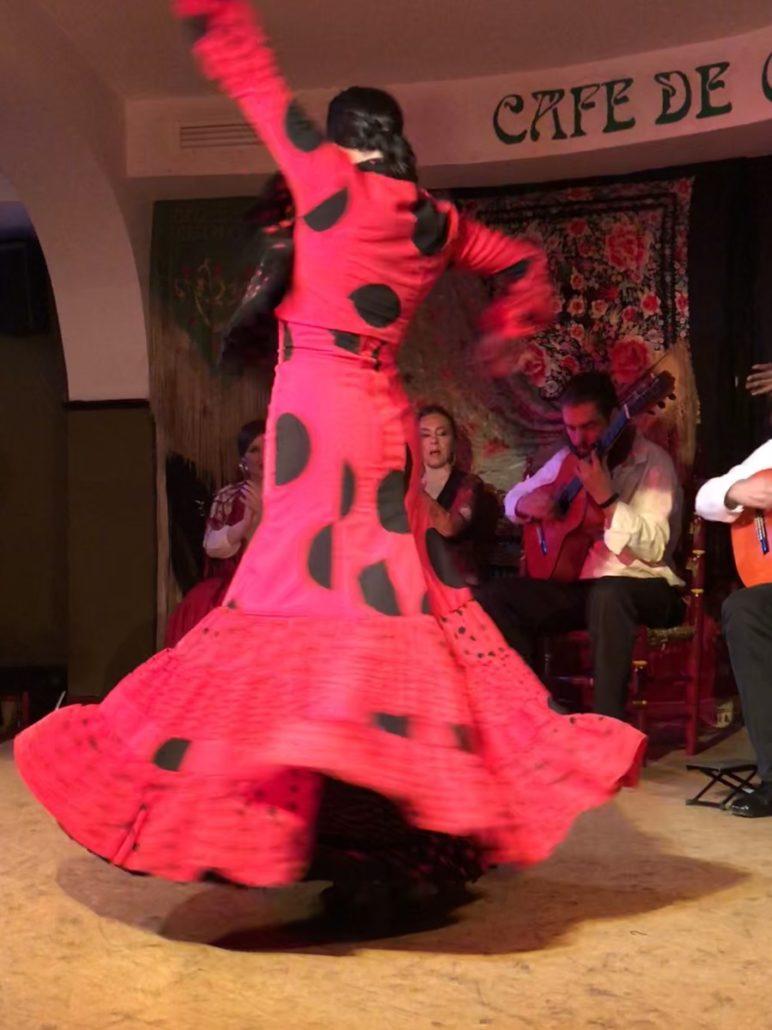 Writer José Luis Castillo-Puche published a report on the tablaos of Madrid, titled “Madrid, the Seat of Flamenco,” whose introduction read: “Any foreigner that comes to Madrid absolutely must visit, at least once, one of the capital’s tablaos. Not only foreigners, but also any Spaniard that comes from elsewhere in Spain; in fact, even the locals, and adopted locals, should do the same. The tablaos are one of the sights to see in Madrid, as much as the Prado Museum, or the Royal Palace, or the Plaza Mayor… In the last several years, the tablaos in the capital city have multiplied. These flamenco spaces are full of character, ambiance, and a characteristic mystery. They are temples dedicated to the religion of Andalusian song and dance. They are not dedicated solely to tourism, though it is inarguable that this modern rendition of flamenco must give thanks to the mass numbers of tourists visiting Spain in the last fifty years.
Writer José Luis Castillo-Puche published a report on the tablaos of Madrid, titled “Madrid, the Seat of Flamenco,” whose introduction read: “Any foreigner that comes to Madrid absolutely must visit, at least once, one of the capital’s tablaos. Not only foreigners, but also any Spaniard that comes from elsewhere in Spain; in fact, even the locals, and adopted locals, should do the same. The tablaos are one of the sights to see in Madrid, as much as the Prado Museum, or the Royal Palace, or the Plaza Mayor… In the last several years, the tablaos in the capital city have multiplied. These flamenco spaces are full of character, ambiance, and a characteristic mystery. They are temples dedicated to the religion of Andalusian song and dance. They are not dedicated solely to tourism, though it is inarguable that this modern rendition of flamenco must give thanks to the mass numbers of tourists visiting Spain in the last fifty years.
We hope you will join us on this journey and become part of flamenco’s history. Come with us to experience an unforgettable story…

